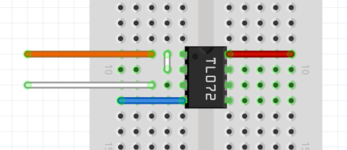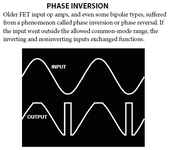grieih
Newbie

Hi,
I'm trying to build a simple voltage follower using a TL072IP op-amp I got, just for learning purposes. Something similar to this (image from Wikipedia):

Here we can see the inputs/outputs for the amplifier according to the vendor's datasheet:

And this is the circuit I came up with:

However, no matter what I connect "IN+" to (5V or 0) the output is always the same: ~4.64V. I expected to have either 5V or 0 at the output. If I left the input floating, the output goes down to ~1.5V.
I tried to make sure the connections are OK, read the datasheet, and also tried using the second op-amp from the package (as this part is a dual one) but the result is the same.
Can anybody help me understanding this circuit? What am I doing wrong?
Thanks in advance.
I'm trying to build a simple voltage follower using a TL072IP op-amp I got, just for learning purposes. Something similar to this (image from Wikipedia):
Here we can see the inputs/outputs for the amplifier according to the vendor's datasheet:
And this is the circuit I came up with:
However, no matter what I connect "IN+" to (5V or 0) the output is always the same: ~4.64V. I expected to have either 5V or 0 at the output. If I left the input floating, the output goes down to ~1.5V.
I tried to make sure the connections are OK, read the datasheet, and also tried using the second op-amp from the package (as this part is a dual one) but the result is the same.
Can anybody help me understanding this circuit? What am I doing wrong?
Thanks in advance.



